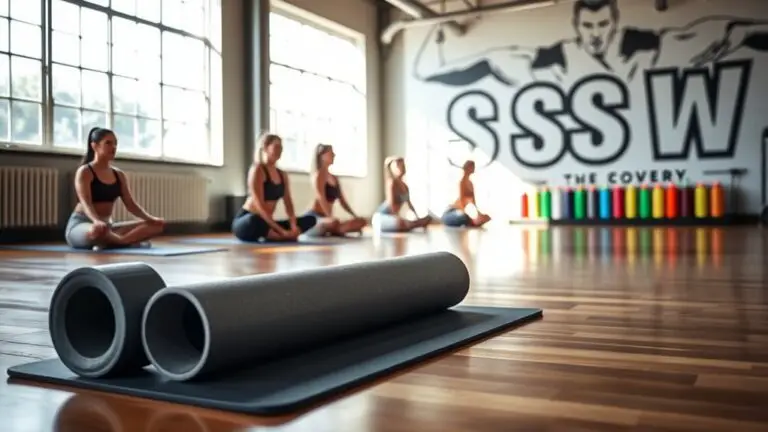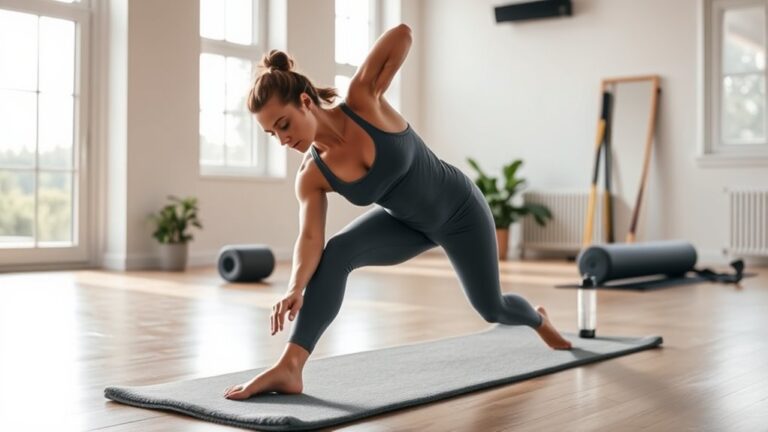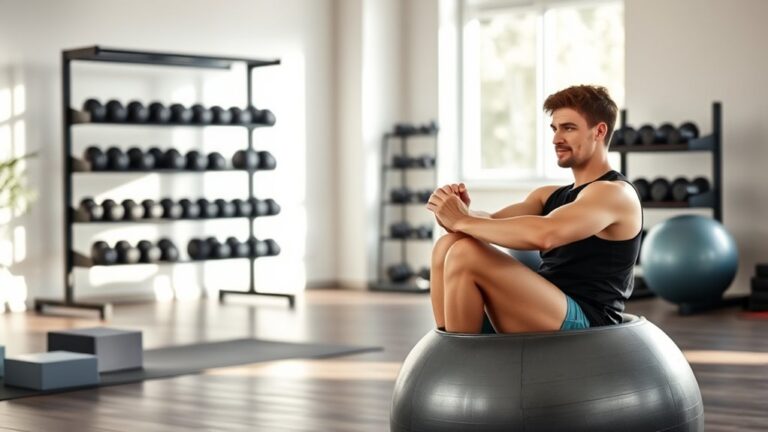How to Use Foam Rolling and Massage to Prevent Injuries

To prevent injuries, use foam rolling and massage effectively. Foam rolling enhances muscle recovery by reducing tightness and improving flexibility. Target specific muscle groups, like hamstrings and quadriceps, for maximum benefits. Incorporate massage techniques, such as deep tissue or sports massage, to alleviate tension and boost circulation. Aim for sessions two to three times a week, both after workouts and on rest days. By doing this consistently, you’ll support your muscle health and performance. Explore further techniques and schedules for even better results.
Understanding Foam Rolling and Its Benefits

Foam rolling, often referred to as self-myofascial release, is an effective technique for enhancing muscle recovery and preventing injuries. By applying pressure to specific muscle groups, you can release tightness and improve blood flow, which aids in nutrient delivery and waste removal. The foam rolling benefits include increased flexibility, reduced muscle soreness, and improved range of motion.
To maximize these benefits, it’s essential to employ ideal techniques. Begin by identifying tight areas, rolling slowly over them for 30 seconds to two minutes. Use your body weight to apply sufficient pressure, but avoid rolling over bony areas or joints. Incorporating deep, controlled breaths can enhance relaxation and effectiveness. Regular foam rolling sessions, ideally post-exercise or on rest days, can greatly contribute to your overall muscle health and performance. By integrating foam rolling into your routine, you’re setting yourself up for better recovery and reduced injury risk.
The Science Behind Massage Therapy
Understanding the science behind massage therapy reveals its significant physiological effects, including improved blood circulation and muscle relaxation. These mechanisms contribute to pain relief and enhanced recovery processes, making massage a valuable tool in injury prevention. By grasping how these elements interact, you can optimize your approach to recovery and performance.
Physiological Effects Explained
While you might think of massage therapy as a luxury or a tool for relaxation, its physiological effects are deeply rooted in science and can play a crucial role in injury prevention. Understanding these effects can help you appreciate its value more fully. Here are three key physiological responses to massage:
- Increased Blood Flow: Massage promotes circulation, ensuring muscles receive essential nutrients and oxygen for peak function.
- Enhanced Muscle Elasticity: Regular massage improves muscle elasticity, reducing the risk of strains and tears.
- Reduced Muscle Tension: By alleviating tightness, massage can help maintain proper muscle function and biomechanics.
These physiological responses contribute to overall muscle health, making massage therapy an effective tool in your injury prevention arsenal.
Pain Relief Mechanisms
Massage therapy not only promotes muscle health but also activates various pain relief mechanisms that can greatly enhance recovery. One key aspect is pain modulation, which alters the perception of pain through the nervous system. Additionally, massage facilitates muscle relaxation, reducing tension and soreness. Here’s a brief overview of these mechanisms:
| Mechanism | Description |
|---|---|
| Pain Modulation | Alters pain signals in the nervous system |
| Muscle Relaxation | Reduces muscle tension and tightness |
| Increased Blood Flow | Enhances circulation to promote healing |
| Endorphin Release | Triggers the release of natural painkillers |
Understanding these mechanisms can help you leverage massage therapy effectively, ultimately leading to improved recovery and injury prevention.
Enhanced Recovery Processes
When considering recovery from physical exertion, the role of massage therapy becomes evident through its physiological effects on the body. It promotes enhanced recovery by facilitating the following processes:
- Increased Blood Flow: Massage enhances circulation, delivering oxygen and nutrients to muscles while removing waste products, essential during active recovery.
- Muscle Relaxation: This therapy reduces muscle tension, improving flexibility, especially when combined with dynamic stretching.
- Pain Reduction: By activating the body’s natural pain relief mechanisms, massage therapy can decrease discomfort, allowing for more effective recovery.
Incorporating massage into your routine not only complements active recovery strategies but also optimizes overall performance, helping you return to training faster and with reduced risk of injury.
How Foam Rolling Enhances Muscle Recovery
Foam rolling can greatly enhance your muscle recovery by increasing blood flow to targeted areas. This improved circulation helps deliver essential nutrients and oxygen, promoting faster healing and reducing muscle soreness. Incorporating foam rolling into your routine can consequently lead to more effective recovery after intense workouts.
Increased Blood Flow
Enhanced circulation is a key benefit of foam rolling, markedly impacting muscle recovery. By promoting increased circulation, foam rolling enhances muscle oxygenation, allowing for more efficient nutrient delivery to your muscles. This process can aid in reducing fatigue and improving overall performance. Here are three ways foam rolling facilitates increased blood flow:
- Vasodilation: The pressure applied during foam rolling stimulates blood vessel expansion, enhancing circulation.
- Lactic Acid Removal: Improved circulation helps eliminate lactic acid buildup, which can hinder recovery.
- Enhanced Nutrient Delivery: Increased blood flow ensures that essential nutrients reach your muscles, promoting faster recovery.
Incorporating foam rolling into your routine can markedly enhance your muscle recovery process, guaranteeing your body is primed for your next workout.
Reduced Muscle Soreness
Research indicates that incorporating foam rolling into your post-workout routine can considerably reduce muscle soreness. This technique enhances muscle recovery by breaking down fascia and increasing blood flow, which aids in the removal of metabolic waste. As a result, you’ll experience significant soreness reduction, allowing you to train more effectively.
| Foam Rolling Benefits | Mechanism | Recommended Duration |
|---|---|---|
| Soreness reduction | Breaks down muscle knots | 10-15 minutes |
| Improved flexibility | Increases range of motion | 10-15 minutes |
| Enhanced recovery | Promotes circulation | 10-15 minutes |
Incorporating foam rolling into your regimen can optimize your post-exercise recovery, leading to improved performance in subsequent workouts.
Techniques for Effective Foam Rolling

Using effective techniques for foam rolling can greatly enhance your recovery and injury prevention strategies. To optimize your self myofascial release, follow these essential methods for pressure application:
- Target Specific Muscle Groups: Focus on areas like your calves, thighs, and back. Rolling over these muscles helps break up knots and improve circulation.
- Control Your Pressure: Adjust the intensity of your pressure application according to your comfort level. Start gently and gradually increase the pressure as your muscles adapt, ensuring you avoid excessive discomfort.
- Maintain Consistency: Incorporate foam rolling into your routine at least 2-3 times per week. Consistent practice helps maintain muscle elasticity and reduces the risk of injuries over time.
Incorporating Massage Into Your Routine
Incorporating massage into your routine can enhance recovery and injury prevention. You’ll want to explore various types of massage techniques, such as Swedish or deep tissue, to find what suits your needs best. Additionally, understanding the ideal frequency and timing for these sessions can maximize their benefits.
Types of Massage Techniques
While you may think of massage as a luxury, integrating various techniques into your routine can greatly enhance your recovery and prevent injuries. Here are three effective types of massage:
- Deep Tissue Massage: Targets deeper muscle layers, breaking down knots and alleviating chronic pain, ideal for athletes.
- Sports Massage: Focuses on specific muscle groups used in sports, incorporating techniques like trigger point and myofascial release to enhance performance and recovery.
- Aromatherapy Massage: Combines essential oils with gentle pressure, promoting relaxation and reducing muscle tension.
Other techniques like Swedish massage, lymphatic drainage, shiatsu therapy, prenatal massage, and hot stone therapy can also be beneficial, depending on your specific needs. Incorporating these methods can optimize recovery and support injury prevention.
Frequency and Timing Tips
Integrating massage into your routine requires careful consideration of frequency and timing to maximize its benefits for injury prevention. Frequency guidelines suggest that incorporating massage sessions two to three times a week can greatly enhance muscle recovery and flexibility. Each session should ideally last between 30 to 60 minutes, ensuring adequate time for muscle relaxation. As for timing recommendations, consider scheduling massages after intense workouts to facilitate recovery or on rest days to maintain muscle health. Additionally, pre-workout massages can help improve circulation and prepare your muscles for activity. By thoughtfully applying these frequency and timing strategies, you’ll optimize the effectiveness of your massage regimen, ultimately reducing the risk of injuries and enhancing your overall performance.
Targeting Specific Muscle Groups With Foam Rolling
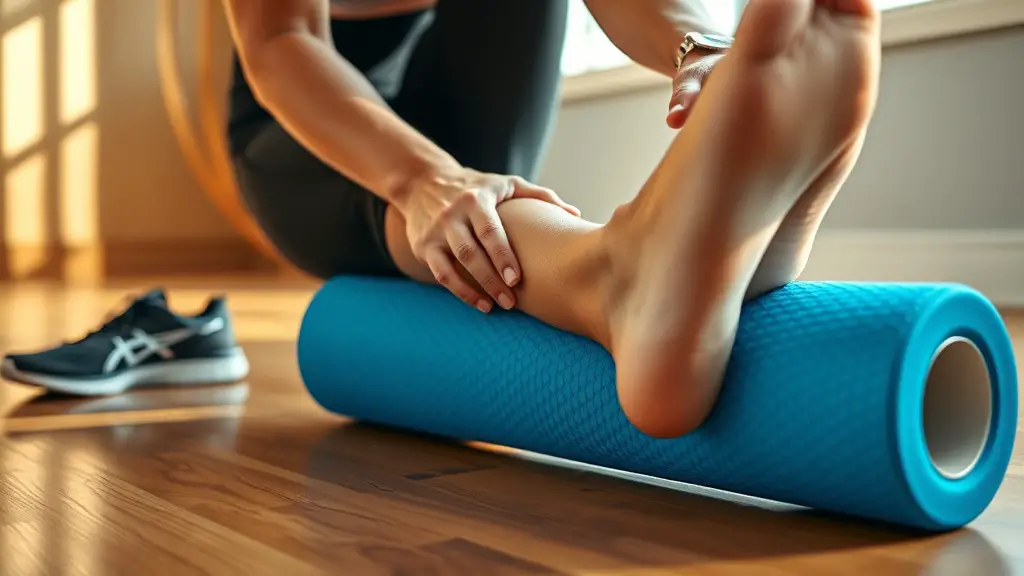
When you want to maximize the benefits of foam rolling, it’s essential to target specific muscle groups that are prone to tension and injury. Utilizing targeted techniques can greatly enhance your recovery and performance. Here are three key muscle groups to focus on:
- Quadriceps: These muscles often tighten due to extended periods of sitting or intense workouts. Rolling can improve flexibility and reduce pain.
- Hamstrings: Tight hamstrings can lead to imbalances and injuries. Foam rolling helps alleviate tension and promotes better movement patterns.
- Upper Back: The upper back is frequently neglected, yet it’s important for posture. Rolling here can relieve stress and improve overall function.
Identifying Tight Muscles and Trigger Points
To effectively prevent injuries, it is crucial to identify tight muscles and trigger points within your body. Conducting a thorough muscle assessment can help you locate these areas of tension, which often contribute to pain and reduced mobility. Trigger point identification involves palpating specific muscle regions to find knots or areas that elicit pain upon pressure.
Here’s a simple table to guide your assessment:
| Muscle Group | Common Symptoms | Trigger Point Locations |
|---|---|---|
| Quadriceps | Knee pain, tightness | Upper thigh near hip joint |
| Hamstrings | Lower back pain, stiffness | Back of thigh near knee |
| Shoulders | Neck pain, headaches | Upper shoulder near neck |
Combining Foam Rolling and Massage for Optimal Results
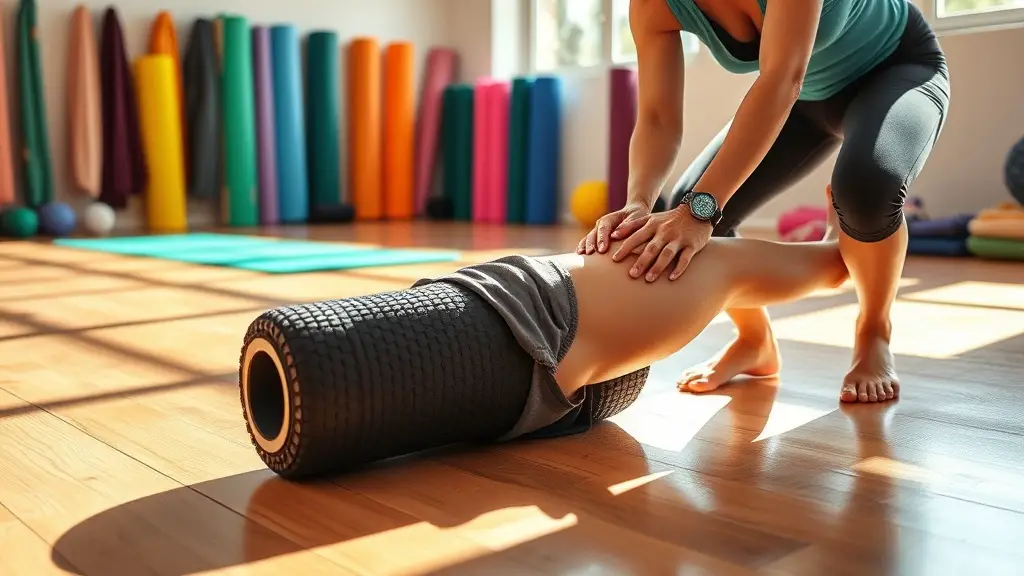
How can you maximize the benefits of foam rolling and massage in your injury prevention routine? Combining these two modalities can enhance muscle recovery and flexibility, leading to reduced injury risk. Here are three effective strategies for integrating foam rolling techniques with massage:
- Sequence of Application: Start with foam rolling to loosen tight muscles and fascia, targeting trigger points. Follow up with massage to enhance blood flow and further release tension.
- Focus on Specific Areas: Use foam rolling on larger muscle groups like quads and hamstrings, while utilizing massage for smaller, intricate areas such as the shoulders and neck. This approach guarantees thorough care.
- Timing and Frequency: Incorporate both practices post-workout or on rest days. Regular massage integration with foam rolling can facilitate quicker recovery, allowing you to maintain your training regimen without setbacks.
Tips for Creating a Recovery Schedule
Incorporating foam rolling and massage into your routine is just one part of an all-encompassing approach to injury prevention. To maximize their benefits, it’s essential to establish a recovery schedule that emphasizes recovery frequency and schedule consistency. Aim for at least two to three foam rolling sessions per week following intense workouts, and incorporate massage therapy monthly to address deeper muscle tensions.
Consistency is key; set specific days and times for your recovery sessions to create a habit. You might find that mornings or post-workout periods are ideal for foam rolling, while evening massages can facilitate relaxation and recovery.
Keep track of your schedule in a planner or app, adjusting it as needed based on your training intensity and body feedback. By prioritizing recovery in your routine, you’re not just preventing injuries but also enhancing overall performance and well-being.
Common Mistakes to Avoid When Foam Rolling and Massaging
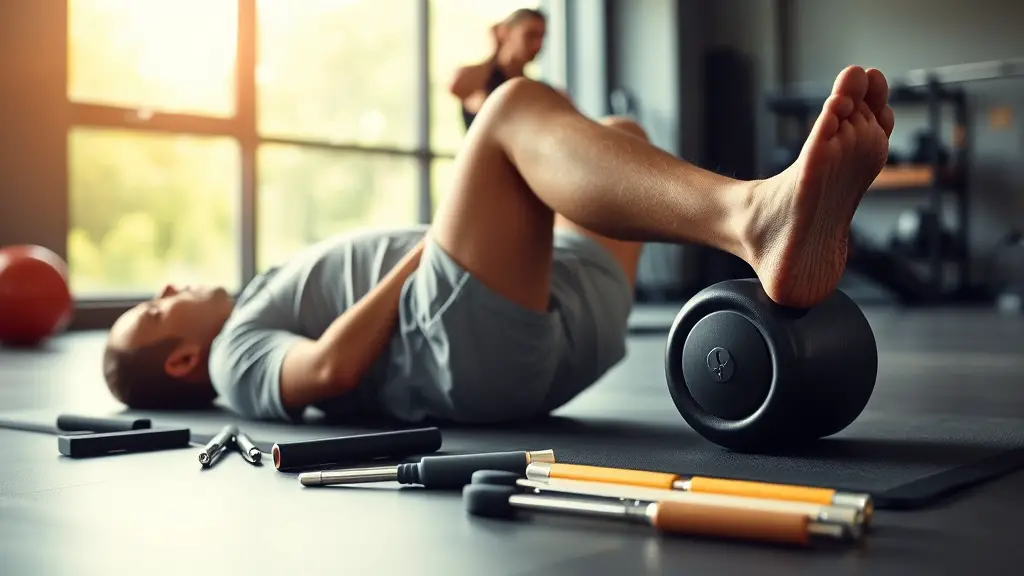
While foam rolling and massage can greatly enhance recovery and prevent injuries, there are common mistakes that can undermine their effectiveness. Avoiding these foam rolling mistakes and massage errors guarantees you reap the full benefits.
- Rolling Too Quickly: When you rush through your foam rolling, you miss the chance to truly target tight spots. Take your time, spending at least 30 seconds on each area to achieve the best results.
- Neglecting Breathing: Holding your breath can increase tension in your muscles. Focus on deep, steady breaths to help relax your body, allowing for a more effective release of muscle tightness.
- Applying Excessive Pressure: It’s easy to think more pressure equals better results, but this can lead to injury. Use controlled, moderate pressure to avoid bruising or overstraining your muscles during both foam rolling and massage.
Frequently Asked Questions
Can Foam Rolling Help With Chronic Pain Conditions?
Foam rolling can be an effective tool for managing chronic pain conditions. It helps release muscle tension and improve blood circulation, which can alleviate discomfort. Research shows that regular foam rolling may enhance flexibility and reduce soreness, making it beneficial for those suffering from persistent pain. By incorporating foam rolling into your routine, you might experience improved mobility and a reduction in the intensity of your chronic pain symptoms, leading to better overall function.
How Often Should I Use Foam Rollers for Best Results?
To achieve peak results, foam rolling frequency should ideally be three to five times a week. This allows your muscles to recover and reduces soreness. When using foam rolling techniques, focus on major muscle groups and spend about 1-2 minutes on each area. Research supports this routine, showing that consistent foam rolling can enhance flexibility and alleviate muscle tightness. Ultimately, listening to your body’s response will guide your ideal frequency for best results.
Is There an Ideal Time to Foam Roll Before or After Workouts?
The ideal time to foam roll is both before and after workouts. Pre workout, foam rolling provides benefits like increased blood flow and improved range of motion, enhancing your performance. Post workout, it aids in recovery by reducing muscle soreness and promoting relaxation. Research shows that integrating foam rolling into your routine can greatly decrease the risk of injuries while improving overall muscle function, making it a valuable practice for anyone engaged in physical activity.
Are There Any Contraindications for Foam Rolling or Massage?
Before you immerse yourself in foam rolling or massage, you should know that not everyone’s body loves these techniques. If you’ve got specific injuries like fractures, recent surgeries, or severe skin conditions, it’s best to avoid them. Medical conditions such as deep vein thrombosis or certain cardiovascular issues can also make foam rolling risky. Always consult with a healthcare professional to guarantee you’re not putting yourself at unnecessary risk while trying to enhance your recovery.
Can Foam Rolling Be Beneficial for Older Adults?
Absolutely, foam rolling can be beneficial for older adults. It helps improve age-related flexibility by enhancing blood flow and reducing muscle tension. Research shows that regular foam rolling can increase range of motion, making daily activities easier and less painful. Additionally, it may aid in recovery after exercise, which is vital for maintaining an active lifestyle. So, incorporating foam rolling into your routine could really enhance your overall mobility and comfort.


